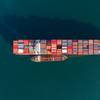Indecision from Russia regarding help from foreign nations in aiding efforts to rescue an estimated 118 sailors trapped in a Nuclear submarine lying on the bottom of the Barents Sea evaporated today, as Norway said that divers due to join a British bid to save 118 Russian sailors trapped in a submarine on the bed of the Barents Sea would arrive on Saturday.
Meanwhile, Prime Minister Mikhail Kasyanov said on Thursday the situation around the sunken nuclear submarine Kursk was "next to catastrophic", but he hoped chances remained to save its 118 crew, Russian news agencies reported. "During the past night there were no changes for better or worse," Interfax news agency quoted Kasyanov as telling a government meeting. "We want to hope that there are chances to rescue the crew."
The navy said the crew of the Kursk submarine, on the bottom of the Arctic Barents sea since the weekend, stopped tapping SOS signals on the hull on Tuesday.
The Seaway Eagle, carrying 12-15 divers, was likely to arrive off north Russia at around midday on Saturday, roughly the same time as a separate supply vessel - the orange-painted supply vessel Normand Pioneer -- carrying a British mini-submarine which will be used to try to rescue the crew of the Kursk.
"The divers should arrive at about the same time as the British on Saturday," Foreign Ministry spokesman Karsten Klepsvik said. The ministry had initially estimated the divers would arrive on Friday night.
Russia asked Oslo and London for help on Wednesday to rescue the crew, stranded on the seabed since the weekend, despite growing worries that the bid would be too late.
The British team left the Norwegian port of Trondheim on Thursday morning for a 50-hour voyage to the site of the stricken submarine.
The Norwegian divers are due to help the British submarine in its bid to lock onto the hatches of the Kursk to let survivors escape. A string of Russian attempts to free the crew have so far failed in stormy, murky seas swept by strong currents.
Klepsvik said the Seaway Eagle could be further delayed, however, if it needed to put into port for fuel and other supplies.
Divers on the Norwegian vessel had been working on the Aasgaard oil and gas field off North Norway, operated by state oil firm Statoil.
A shipyard in northern Norway also said it had been asked whether it could make an extra piece of equipment to help link the British mini-submarine, dubbed LR5, to the hatch of the Kursk.
"We can do a job like this. If we get the contract, it will get the highest priority," Greger Mannsverk, the managing director of the Kvaerner Kimek firm, told the daily Aftenposten.
Slim Chance, But A Chance
"We've got to be optimistic. There's always a chance," commander Alan Hoskins of the British navy's submarine rescue team said just before leaving for a voyage around the north of Norway due to take just over two days. "An operation like this is never straightforward. We expect it to be complicated because we know (the submarine's lying) at an angle and there are currents," he said. "But we don't know until we are there."
British officials said the LR5 mini-sub had been flown to Trondheim from Scotland on Wednesday rather than to the Russian airport of Murmansk -- far closer to the crippled submarine -- because it needed to be mounted on a specialized mother ship.
"The important thing was to get it on a mother ship. There aren't too many ships capable of doing this," Commander David Stanesby said.
Featured videos

Tracking Foreign Vessels Working in the U.S. Jones Act Market

Inside the Electrified Truckable Tug

Inmarsat Enhances Service to Drive Digitalization
Subscribe for
Maritime Reporter E-News
Maritime Reporter E-News is the maritime industry's largest circulation and most authoritative ENews Service, delivered to your Email five times per week









